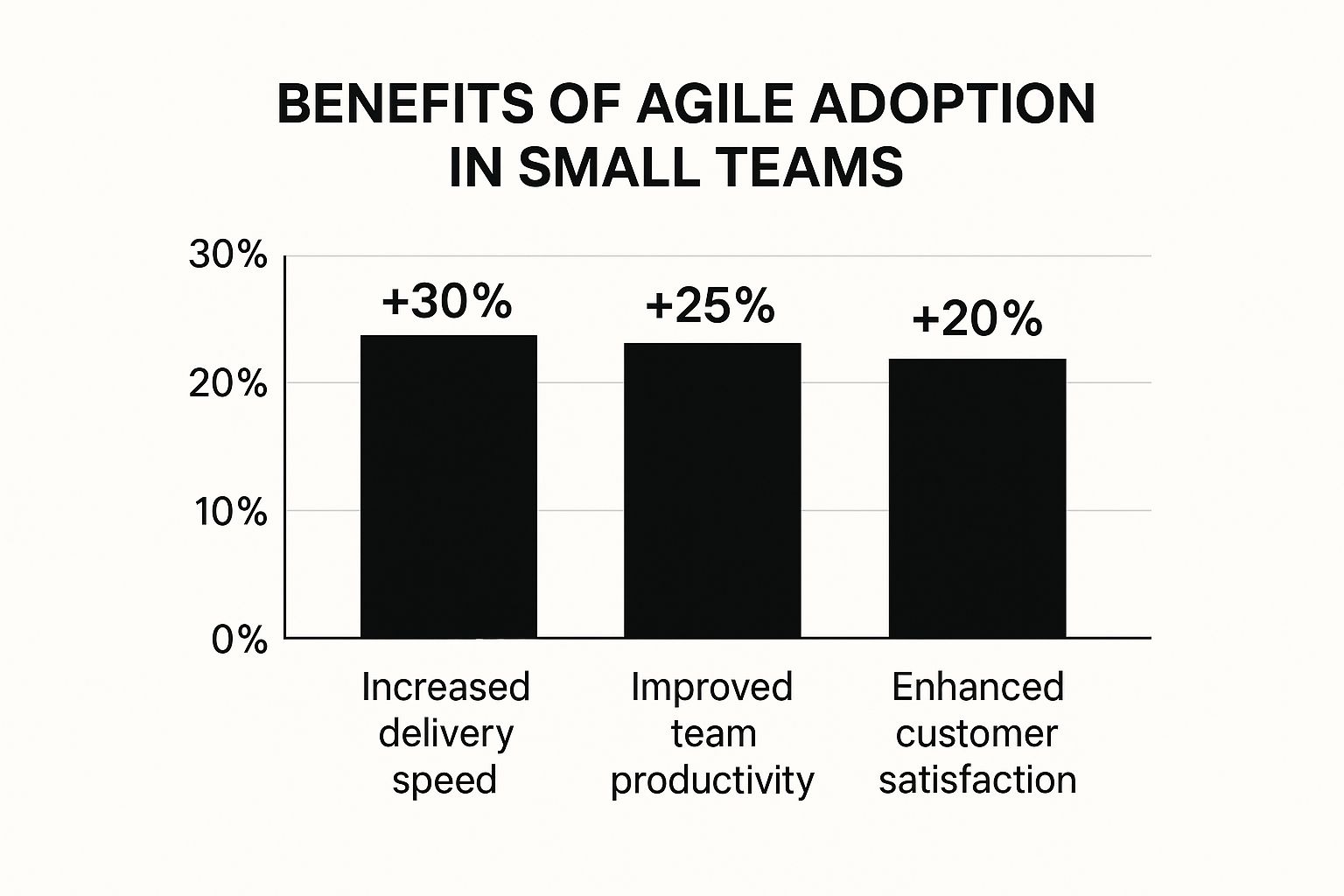Agile Methodology for Small Teams A Practical Guide
Agile Methodology for Small Teams A Practical Guide
For small teams, "agile" isn't just another corporate buzzword—it's a survival strategy. Unlike massive corporations with deep pockets and entire departments for every little thing, smaller outfits have to be nimble. You don't have the luxury of getting it wrong.
The agile methodology gives small teams a framework that hits their biggest challenges head-on: tight resources, the need for speed, and the ability to pivot without derailing the whole operation.
Why Old-School Project Management Fails Small Teams
Think about traditional project management, often called the "waterfall" method. It’s all about massive, upfront planning. Every single phase—from requirements and design to development and testing—has to be locked in and completed before the next one can even start.
For a small team, this rigid structure can be a death sentence. What happens when a competitor launches a new feature, or a key customer gives you unexpected feedback halfway through a six-month project? You’re stuck. Agile flips that entire model on its head.
The Power of Being Able to Adapt
Instead of one giant, high-stakes launch, agile breaks work down into small, manageable cycles called sprints. This approach is all about continuous feedback and constant adjustment.
Here’s where it really clicks for small teams:
- Deliver Value, Faster: You can get a working piece of your product into the hands of real users quickly. This means you're gathering actual data instead of just guessing what people want.
- Slash Your Risk: By building and testing in tiny increments, you spot problems early. You avoid the nightmare scenario of wasting months on a feature that nobody ends up using.
- Actually Collaborate: Agile demands daily communication. It ensures everyone, from the person writing code to the person designing the UI, is on the same page and chasing the same immediate goal.
This iterative rhythm makes agile a perfect match for the fast-and-furious world most small businesses live in. It turns market uncertainty from a threat into an advantage.
The infographic below really drives home the gains small teams experience with agile, especially when it comes to speed, productivity, and keeping customers happy.

As the data shows, that +30% jump in delivery speed is a massive win. For small teams trying to make a mark, getting to market faster is everything.
To see how these two approaches stack up in the real world, let's compare them side-by-side.
Agile vs. Waterfall for Small Teams
| Aspect | Agile Approach | Traditional Waterfall Approach |
|---|---|---|
| Planning | Adaptive and iterative; plans evolve as you learn. | Rigid and upfront; the entire project is planned from the start. |
| Feedback | Continuous feedback loops with stakeholders and users. | Feedback is gathered late, typically after a major release. |
| Flexibility | High; changes are welcomed and easily incorporated. | Low; changes are difficult, costly, and often discouraged. |
| Risk | Lower; issues are identified and fixed early in the process. | High; major problems might not be discovered until the very end. |
| Delivery | Fast and incremental; you deliver value in small chunks. | Slow and monolithic; one big delivery at the end of the project. |
The table makes it clear why agile just works for small teams. The ability to adapt and learn is baked right into the process, which is essential when you don't have the resources to absorb a major misstep.
The Proof Is in the Pudding
This isn't just a hunch; the numbers tell the same story. A recent study found that 52% of small businesses feel agile is more effective for them than it is for larger companies. It’s no wonder that a staggering 98% of all businesses say agile has been a key part of their success. You can dive deeper into these agile development statistics to see just how widespread its adoption has become.
For a small team, the biggest waste is building the wrong thing. Agile’s tight feedback loops are the best defense against this, ensuring every ounce of effort contributes directly to customer value and business growth. It shifts the focus from "did we follow the plan?" to "did we solve the right problem?"
Choosing Your Flavor of Agile: Scrum vs. Kanban
Jumping into agile doesn't mean you have to cram your team into some rigid, one-size-fits-all box. The whole point of agile, especially for a small team, is its flexibility. Your first big decision is figuring out which framework feels right for your team's natural rhythm and the kind of work you do. The two most common—and frankly, most practical—choices are Scrum and Kanban.
Think of it like this: Scrum is the high-intensity interval training (HIIT) of the project world, with structured work periods and built-in rest. Kanban is more like a steady, continuous marathon where you just keep moving. Neither is "better," they just solve different problems.
Scrum: Structure and Time-Boxes
Scrum is all about working in short, focused bursts called sprints. These are typically one or two weeks long. At the beginning of each sprint, the team looks at the to-do list and agrees on a specific chunk of work they can finish in that timeframe. This creates a predictable rhythm that's fantastic for projects with clear goals and deadlines.
It’s a great fit for scenarios like:
- Building out a brand-new product feature.
- Running a marketing campaign that has a non-negotiable launch date.
- Developing an MVP where you absolutely need to deliver a working piece of the product in a short, predictable window.
The defined roles and ceremonies in Scrum (which we’ll get into later) build a strong sense of accountability. It forces everyone to break down big, intimidating projects into smaller, more manageable pieces, which is a huge motivator.
Kanban: Continuous Flow and Flexibility
Kanban, on the other hand, is all about visualizing your workflow and keeping things moving. Instead of fixed sprints, tasks flow across a board—think of a Trello board—from a "To Do" column to "In Progress" and finally to "Done." The secret sauce here is limiting your Work in Progress (WIP), which prevents team members from getting swamped by juggling too many things at once.
This approach really shines when your work is less predictable and priorities can change on a dime. It's a lifesaver for:
- Marketing teams fielding a constant stream of content requests.
- Customer support teams managing an endless queue of tickets.
- A small agency trying to balance multiple client projects with different deadlines.
With Kanban, you get maximum flexibility. There are no sprints to plan. If an urgent task lands on your desk, you just add it to the board and someone can pull it into their workflow as soon as they have capacity.
Key Takeaway: The real difference is how they handle work. Scrum pushes work through in time-based batches (sprints). Kanban pulls work through continuously as team members become available.
To make the right call, just look at how your team operates. If you're building a product with distinct phases and milestones, Scrum’s structure will provide that much-needed focus. But if you’re managing an ongoing river of tasks, Kanban’s flexibility is your best bet to avoid bottlenecks and keep everyone sane.
Defining Agile Roles Without Corporate Overhead

In a small team, everyone wears multiple hats. The idea of slapping on formal titles like "Product Owner" or "Scrum Master" can feel like you're just adding a stuffy corporate layer where it doesn’t belong. It can even feel a little silly.
The secret to making agile work for small teams is to forget the titles and focus on the responsibilities. This way, you avoid creating bottlenecks or killing the collaborative spirit that makes your team so effective in the first place. You simply distribute the duties based on who's already best suited for them.
The Product Visionary
Every project needs a North Star—someone who lives and breathes the customer’s needs and holds the product vision. In a giant corporation, this is the official Product Owner. On your team, it’s probably the founder, CEO, or a lead product person who already has a direct line to the customer's world.
This person is in charge of a few critical things:
- Defining the "what" and "why" behind every task.
- Prioritizing the backlog so the team is always focused on what delivers the most value.
- Making the final call on whether a new feature actually solves the user's problem.
The goal isn't to create a new manager. It's about clarifying who has the final say on product direction to keep the vision consistent. A clear vision also needs solid validation, which is where testing comes in. You can learn more about how this fits into the bigger picture in our guide on software testing best practices.
The Team's Facilitator
Just like the product visionary, the "Scrum Master" role isn't about management. It's about facilitation and clearing roadblocks. Think of this person as a servant-leader, whose main job is to protect the team from distractions and keep the agile process humming along smoothly.
This responsibility often falls naturally to the most organized person on the team—maybe your project manager or a senior dev who has great communication skills.
This person is the team's protector. Their job is to clear roadblocks, whether it's an uncooperative stakeholder, a technical issue, or just a meeting that’s running too long. They champion the agile process so everyone else can focus on their work.
They'll be the one running daily stand-ups, helping the team stick to its commitments, and guiding those all-important retrospective meetings. By focusing on these core functions, you get all the benefits of agile roles without any of the corporate baggage.
Mastering Agile Ceremonies That Actually Work

Let's be honest, the term "agile ceremonies" can make even seasoned pros groan. We've all been in those endless meetings that feel more like a bureaucratic chore than a productive use of time.
But for a small team, these aren't just boxes to check. They are your secret weapon—high-impact touchpoints that keep everyone in sync and moving at speed. When you get them right, they become the heartbeat of your project, not a drain on your energy. The trick is to keep them lean, focused, and genuinely valuable.
The Ultra-Fast Daily Stand-Up
The daily stand-up needs to be the quickest meeting of your day, hands down. Its sole purpose is to get a quick sync, call out any roadblocks, and let everyone get back to what they do best. For a small, focused team, this should take no more than ten minutes.
Each person just needs to answer three simple questions:
- What did I get done yesterday?
- What's on my plate for today?
- Is anything getting in my way?
That's it. This isn't a deep-dive problem-solving session or a status report for a manager. If someone mentions a blocker that needs a bigger discussion, park it. The right people can huddle up immediately after the stand-up to hash it out. This keeps the meeting sharp and shows respect for everyone's time.
Pro Tip: Actually stand up. It might sound silly, but it creates a subtle sense of urgency that keeps the meeting from dragging. If your team is remote, keep those cameras on to build connection and keep everyone engaged.
Collaborative Sprint Planning
Sprint Planning is where you set the tone for the entire sprint. This isn't about a product owner handing down a list of orders from on high. It's a true workshop, a collaborative session where the entire team decides what can realistically be accomplished together.
The person with the product vision brings the highest-priority items from the backlog to the table. From there, it's a team conversation. People ask questions, get clarity, and then pull work into the sprint based on their collective capacity. This shared ownership is what turns a "sprint goal" from a corporate mandate into a genuine team commitment. A two-hour session is plenty for a two-week sprint.
Showcasing Work in the Sprint Review
Think of the Sprint Review less as a scary performance evaluation and more as a "show and tell." It's the team's chance to demonstrate the real, working product they've built. It’s a moment to celebrate what you've accomplished and, more importantly, get instant feedback from stakeholders.
This is where you feel the value of working in small, powerful increments. You get to put your work in front of people and make sure you're building something they actually want and will use. For a small team, this should feel informal—a demo followed by a conversation, not a stuffy, slide-heavy presentation.
The Retrospective: Fueling Real Improvement
Of all the ceremonies, the retrospective is arguably the most critical for your team's long-term health and success. It's a dedicated, safe space for the team to look back on the last sprint and pinpoint real ways to get better.
To keep it productive, just focus the discussion on three key areas:
- What went well? (What should we keep doing?)
- What didn't go so well? (What should we stop or change?)
- What will we try differently next sprint? (What's our next experiment?)
The most important part? You have to end with concrete, actionable steps. Don't let it devolve into a general complaint session. The goal is to walk away with one or two specific process experiments the team agrees to try in the next sprint. This is how you build a real culture of continuous improvement.
Selecting the Right Tools for Your Agile Team
Choosing the right software can feel like giving your agile team a superpower. But pick the wrong ones, and you'll just create friction and slow everyone down.
For small teams, the goal isn't to snag a platform with a million features. It's about building a lean, simple tech stack that actually supports your workflow—without a massive learning curve or a scary price tag.
Simplicity is your secret weapon here. A clunky, enterprise-grade tool will just bog down a small team with endless configuration and maintenance. Instead, your focus should be on lightweight, intuitive options that start delivering value from day one.
Core Tools for Project Visibility and Communication
Every agile team's tech stack starts with a solid project management tool. Think of it as your single source of truth for who's doing what. Honestly, a simple Kanban board is often all you need to get a complete picture of your workflow.
For instance, take a look at a basic Trello board.
Each card is a task, moving from left to right as work gets done. This visual approach instantly shows you where bottlenecks are popping up, letting the team jump on problems before they derail the entire sprint.
Next up, you need a dedicated place for communication. While email isn't going away, a tool like Slack keeps conversations organized into channels based on topics or projects. When you integrate it with your project management tool, you can automate status updates and free everyone from those tedious check-in meetings. We’ve got more ideas in our guide to essential tools for modern teams.
Your tech stack should feel like a natural extension of your process, not a rigid box you're forced into. The best tools are the ones your team genuinely enjoys using because they make collaboration easier, not harder.
Expanding Your Toolkit for Documentation
Finally, think about a shared space for keeping track of everything else. A platform like Notion is perfect for consolidating project briefs, meeting notes, and technical specs all in one place. This keeps critical information from getting swallowed up in endless email chains or a sea of direct messages.
The agile way of working is spreading far beyond its software development origins. Today, 28% of business operations and 20% of marketing teams are using Agile. Marketers, in particular, are seeing incredible results, reporting a 98% success rate.
This just goes to show that the agile methodology for small teams, when backed by the right tools, can supercharge efficiency across any part of the business. You can dive deeper into these agile adoption trends to see the full picture.
Common Agile Pitfalls and How to Sidestep Them

So you've decided to go Agile. That’s a great first step, but just adopting the framework isn't a silver bullet. I’ve seen countless small teams hit the same frustrating roadblocks on their Agile journey. The good news is, once you know what to look for, these traps are much easier to avoid.
One of the sneakiest pitfalls is accidentally running “mini-waterfall” sprints. It feels productive: week one for design, week two for coding, and the last few days for a frantic testing scramble. But this completely misses the point. You're just cramming a rigid, old-school process into a two-week box, which only delays feedback and guarantees a stressful, last-minute crunch.
The real goal of a sprint is to ship a tiny, fully working piece of the product. Think vertical slice, not horizontal phase.
The Absent Product Visionary
Here's another classic problem, especially in startups: the product owner goes missing. This role is often filled by a founder or CEO who's being pulled in a million different directions. When the person with the product vision isn't around to clarify requirements or prioritize the backlog, the development team grinds to a halt.
You can't afford to have your team building in the dark. The fix is to get a commitment from the product owner for specific, non-negotiable check-in times. If that’s truly impossible, they need to empower a proxy who can make decisions on their behalf. This is a common growing pain for new companies, and we touch on similar challenges in our guide on how to start a tech startup.
Retrospectives can easily become unproductive complaint sessions if they lack structure. The key is to shift the focus from venting about problems to identifying one or two actionable experiments the team can try in the next sprint.
Keeping Ceremonies Productive
Even the most well-meaning Agile ceremonies can lose their way. If your daily stand-ups are stretching to 30 minutes or your retrospectives feel more like a blame game, you've got a problem. These are huge warning signs that your process needs a tune-up.
Here are a few quick-fix tips I've used with my own teams:
- For Stand-ups That Drag On: Set a timer. The moment a discussion veers into deep problem-solving, gently guide it to an offline conversation for later. A stand-up is for quick alignment, not a group debugging session.
- For Stale Retrospectives: Ditch the "what went well, what didn't" format for a sprint. Mix it up with prompts like "Start, Stop, Continue" or the "4Ls" (Liked, Learned, Lacked, Longed For) to generate fresh, actionable insights.
By being proactive and watching for these common issues, you can steer clear of the biggest Agile failures and build a system that actually accelerates your team.
Answering Your Agile Questions
When small teams first start exploring agile, the same questions tend to surface again and again. Getting these sorted out from the beginning helps everyone get on the same page and move forward with confidence. Let's dig into some of the most common ones I hear.
Can We Really Be Agile Without a Dedicated Scrum Master?
You absolutely can. For a small team, the "Scrum Master" is more about a set of responsibilities than a formal job title. Someone still needs to do the work—clearing roadblocks, running meetings, and protecting the team from outside distractions—but those duties can easily be shared. Often, a team member who's naturally organized and a great communicator can step up.
The key is to make sure someone is explicitly empowered to handle those tasks, even if it's not their full-time gig. This keeps the agile process humming along without adding unnecessary corporate-style overhead.
The best agile adoptions I've seen prioritize function over formality. A team member who spends just a few hours a week keeping the team focused can be far more effective than a full-time, certified Scrum Master who just doesn't vibe with the team's culture.
What's the Ideal Sprint Length for a Small Team?
For most small teams, the sweet spot is a one or two-week sprint. This timeframe is long enough to get a meaningful amount of work done, but it's also short enough to get fast feedback and pivot quickly if you need to.
If you're just starting out, try a two-week cycle. It's a solid baseline. From there, you can feel it out and adjust based on your team’s natural rhythm and the type of work you’re doing. The goal is to find a cadence that feels productive, not frantic.
Is It Okay to Mix and Match Scrum and Kanban?
Yes, and honestly, you probably should! Many small teams strike gold by creating a hybrid model, often called "Scrumban." This approach lets you take the best of both worlds and build something that actually fits your workflow.
For example, you could:
- Use a Kanban-style visual board with Work in Progress (WIP) limits to manage the day-to-day flow of tasks.
- Borrow Scrum’s daily stand-ups for quick check-ins and retrospectives to make sure you're always improving.
Remember, the whole point of agile is to be more effective, not to follow a textbook perfectly. Don't be afraid to experiment and build a system that truly works for you.
Ready to turn your agile ideas into real applications without the traditional overhead? With Capacity, you can describe your project in plain English and let AI generate the full-stack web app in minutes—code, UI, and all. Launch your next project 20x faster by visiting https://capacity.so.
